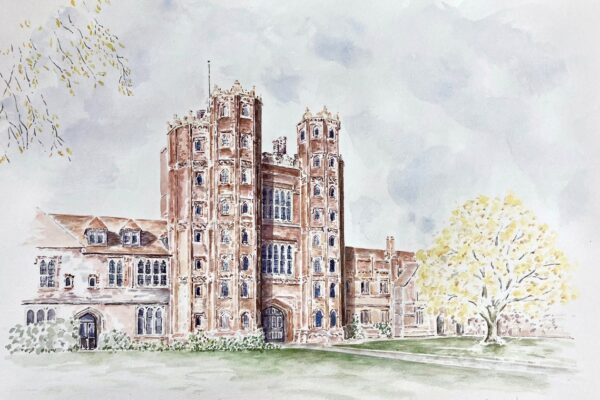Our November Painting: Laura Diggens paints Athelhampton

Peering through the gates on a bright autumn morning, the manor house of Athelhampton was perfectly framed. The house sat assuredly amongst the yellowing tones of foliage and there was a genteel sense of arrival as I wandered up the long walk through the perfectly proportioned lawns leading to the south entrance.
Athelhampton is one of the country’s finest examples of a Tudor Manor house. At its creation in the 15th century, the Great Hall was the entirety of the manor house. Later in the 16th century, the west wing with its beautiful stone mullioned and leaded windows, alongside a south gatehouse were added. The house remained this way until the 19th century when the gatehouse was demolished and a new south wing was created.
Ornate wood and plaster works fill the house with delicate moulded ceilings and carved fireplace surrounds throughout the house. There are dramatic changes in the light and dark of the interiors with smaller wooden panelled bedrooms, offsetting the brightness of the exquisite Great Hall with its abundance of mottled light that pours in through thin veils of glass and fills the vast space under the hammer beam roof.
The gardens of Athelhampton drew me in as I walked toward the house with overflowing hydrangeas to my right and vertiginous yew hedges rising above. On entering the gardens, a series of eight outdoor rooms move you around the grounds which are encircled by the River Piddle. The mild autumn had kept deep red dahlias flowering and golden hues intensified the deep greens of topiary courts. The grandest and most dramatic room of the garden is the Great Court with towering yew pyramids and a sunken fountain overlooked by a balustraded walkway and flanking pavilions. Inspired by the Renaissance, although created in the 19th century, the gardens feel like they could have been created contemporaneously with the Great Hall.
The builders of Athelhampton Manor and the Great Hall were the Martyn family who owned the house until the 17th century after which the house passed to a number of different families including Viscount Wellesley, 5th Earl of Mornington before its current owner took it on in 2019.
Historic literary connections run through Athelhampton as Thomas Hardy visited in the 19th century when his father, a stonemason, was working on repairs of the house. It is here that Hardy was inspired to write his two poems, Dame of Athelhall and The Children and Sir Nameless. Hardy also painted a watercolour of the house showing the south gatehouse, just prior to its demolition.
Since 2019, the property and grounds have undergone a more hidden transformation. The current owners decided to make the entire estate net zero through the introduction of ground source heating and solar panels. A modern sign of the house’s ongoing evolution and a hopeful symbol that its future can be as long as its past.
Related

Athelhampton House & Gardens
Dorchester, Dorset, DT2 7LG
Become a Historic Houses member
Explore the nation’s heritage from just £68 per year.
Hundreds of the most beautiful historic houses, castles, and gardens across Britain offer our members free entry.
Also: receive a quarterly magazine, enjoy monthly online lectures, get exclusive invitations to buy tickets for behind-the-scenes tours, and take up a range of special offers on holidays, books, and other products you might like.



